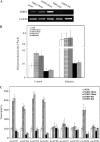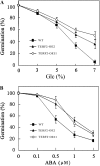Transcriptional regulation of the ethylene response factor LeERF2 in the expression of ethylene biosynthesis genes controls ethylene production in tomato and tobacco
- PMID: 19261734
- PMCID: PMC2675746
- DOI: 10.1104/pp.109.135830
Transcriptional regulation of the ethylene response factor LeERF2 in the expression of ethylene biosynthesis genes controls ethylene production in tomato and tobacco
Abstract
Fine-tuning of ethylene production plays an important role in developmental processes and in plant responses to stress, but very little is known about the regulation of ethylene response factor (ERF) proteins in ethylene biosynthesis genes and ethylene production. Identifying cis-acting elements and transcription factors that play a role in this process, therefore, is important. Previously, a tomato (Solanum lycopersicum [f. sp. Lycopersicon esculentum]) ERF protein, LeERF2, an allele of TERF2, was reported to confer ethylene triple response on plants. This paper reports the transcriptional modulation of LeERF2/TERF2 in ethylene biosynthesis in tomato and tobacco (Nicotiana tabacum). Using overexpressing and antisense LeERF2/TERF2 transgenic tomato, we found that LeERF2/TERF2 is an important regulator in the expression of ethylene biosynthesis genes and the production of ethylene. Expression analysis revealed that LeERF2/TERF2 is ethylene inducible, and ethylene production stimulated by ethylene was suppressed in antisense LeERF2/TERF2 transgenic tomato, indicating LeERF2/TERF2 to be a positive regulator in the feedback loop of ethylene induction. Further research showed that LeERF2/TERF2 conservatively modulates ethylene biosynthesis in tobacco and that such regulation in tobacco is associated with the elongation of the hypocotyl and insensitivity to abscisic acid and glucose during germination and seedling development. The effects on ethylene synthesis were similar to those of another ERF protein, TERF1, because TERF1 and LeERF2/TERF2 have overlapping roles in the transcriptional regulation of ethylene biosynthesis in tobacco. Biochemical analysis showed that LeERF2/TERF2 interacted with GCC box in the promoter of NtACS3 and with dehydration-responsive element in the promoter of LeACO3, resulting in transcriptional activation of the genes for ethylene biosynthesis in tomato and tobacco, which is a novel regulatory function of ERF proteins in plant ethylene biosynthesis.
Figures







References
-
- Acevedo-Hernandez GJ, Leon P, Herrera-Estrella LR (2005) Sugar and ABA responsiveness of a minimal RBCS light-responsive unit is mediated by direct binding of ABI4. Plant J 43 506–519 - PubMed
-
- Achard P, Cheng H, De Grauwe L, Decat J, Schoutteten H, Moritz T, Van Der Straeten D, Peng J, Harberd NP (2006) Integration of plant responses to environmentally activated phytohormonal signals. Science 31 91–94 - PubMed
-
- Alexander L, Grierson D (2002) Ethylene biosynthesis and action in tomato: a model for climacteric fruit ripening. J Exp Bot 3 2039–2055 - PubMed
Publication types
MeSH terms
Substances
LinkOut - more resources
Full Text Sources
Other Literature Sources
Research Materials
Miscellaneous

